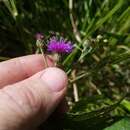Description
provided by eFloras
Plants 6–12(–20+) dm. Stems puberulent. Leaves mostly cauline; blades elliptic to lance-ovate or lanceolate, 6–16(–20+) cm × 18–48+ mm, l/w = 2.5–4(–6+), abaxially usually puberulent to tomentose or pannose (hairs ± erect, ± curled), seldom glabrate, resin-gland-dotted, adaxially scabrellous, glabrescent, not resin-gland-dotted. Heads in corymbiform-scorpioid arrays. Peduncles 3–35 mm. Involucres broadly campanulate to urceolate, (6–)7–10+ × 5–9+ mm. Phyllaries 50–70+ in 6–7 series, sparsely scabrellous, glabrescent (seldom resin-gland-dotted), margins ciliolate, the outer lanceolate, 1–2 mm, inner linear-oblong to oblong, 6–7(–9+) mm, tips acute or rounded-apiculate. Florets 30–55+. Cypselae 3.5–4; pappi stramineous to whitish, outer scales 25–30, 0.5–1.1 mm, contrasting with 35–40+, 6–8+ mm inner bristles. 2n = 34.
- license
- cc-by-nc-sa-3.0
- copyright
- Missouri Botanical Garden, 4344 Shaw Boulevard, St. Louis, MO, 63110 USA
Comprehensive Description
provided by North American Flora
Vernonia missurica Raf. Herb. Raf. 28. 1833
Vernonia fasciculala 0T. & G. Fl. N. Am. 2: 58. 1841.
Vernonia altissima grandifiora A. Gray, Syn. Fl. N. Am. I 2 : 90. 1884.
Vernonia Drummondii Shuttlew.; Werner. Jour. Cine. Soc. Nat. Hist. 16: 171. 1894.
Vernonia interior Drummondii Mackenzie & Hush, Man. Fl. Jackson Co. 190. 1902.
Vernonia illinoensis Gleason, Bull. N. Y. Bot. Card. 4: 211. 1906.
Vernonia Reedii Daniels, Univ. Missouri Stud. Sci. 1: 364. 1907.
Vernonia michiganensis Daniels, Univ. Missouri Stud. Sci. 1: 402. 1907.
Vernonia missurica auslroriparia Gleason, Bull. Torrey Club 46: 245. 1919.
Stems erect, 10-15 dm. tall," branched above, gray-tomentose; leaves numerous, the blades spreading, firm, sessile or short-petioled, lanceolate to ovate-lanceolate, 6-15 cm. long, 1.5-5 cm. wide, long-acuminate, sharply and coarsely serrate to nearly entire, acute or rounded at base, dark-green and scabrellate above, tomentose beneath, at least along the veins; inflorescence flattened or concave, 1-5 dm. broad; heads 34-55-flowered; involucre broadly campanulate, short-cylindric, or hemispheric, 6-8 mm. high; scales appressed, closely and regularly imbricate, purple, or greenish along the midvein, glabrous or puberulent and resinous on the back, arachnoid-ciliate, rounded, obtuse, acute, or mucronate; achenes 4-4.5 mm. long, puberulent to nearly glabrous on the ribs, resinous in the furrows; pappus purple or becoming tawny, the bristles 6-8 mm. long, the scales usually paler, 0.8-0.9 mm. long.
Type locality: Missouri.
Distribution: Ontario and Iowa to Alabama, Mississippi, and New Mexico.
- bibliographic citation
- Per Axel, Rydberg. 1922. CARDUALES; AMBROSIACEAE, CARDUACEAE. North American flora. vol 33(1). New York Botanical Garden, New York, NY
Comprehensive Description
provided by North American Flora
Vernonia aborigina Gleason, Bull. Torrey Club 46: 246. 1919
Stems stout, herbaceous, brown-tomentose, especially above; leaf-blades ovate-lanceolate, 8-15 cm. long, 2-4 cm. wide, acuminate, remotely denticulate with low ascending callous teeth, narrowed below into an obtuse or rounded sessile or subsessile base, scabrous above with short papillose hairs, densely brown-tomentose beneath; inflorescence compact, 11-13 cm. wide, with relatively few heads; heads large, with 55 flowers or more; involucre broadly campanulate, 7-8 mm. high, the scales closely and regularly imbricate, lanceolate to linearoblong, squarrose or recurved at the apex, acute, thinly ciliate at the brown margin, resinous and thinly puberulent at the purple center, elsewhere green and glabrous, the midvein prominent and frequently prolonged into a short mucro; achenes olivaceous, 3.5 mm. long, pubescent on the ribs, resinous in the furrows; pappus red-tawny, the bristles 7 mm. long, the linear scales as long as the diameter of the achene.
Type LOCALITY: Oklahoma, west of Fort Smith, Arkansas. Distribution: Oklahoma.
- bibliographic citation
- Per Axel, Rydberg. 1922. CARDUALES; AMBROSIACEAE, CARDUACEAE. North American flora. vol 33(1). New York Botanical Garden, New York, NY
Vernonia missurica: Brief Summary
provided by wikipedia EN
Vernonia missurica, the Missouri ironweed, is a species of magenta-flowered perennial plant from family Asteraceae native to the central and east central United States.
- license
- cc-by-sa-3.0
- copyright
- Wikipedia authors and editors

